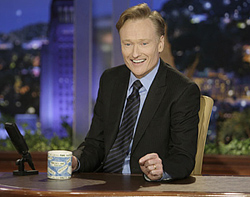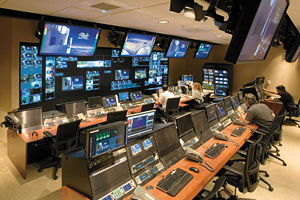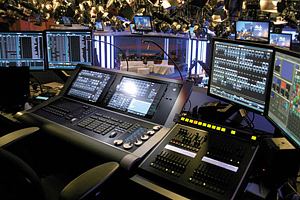Behind the Scenes With Conan
UNIVERSAL CITY, CALIF.
When Conan O'Brien took over the helm of NBC's signature "The Tonight Show" on June 1, production moved from the Burbank studio that Johnny Carson made famous in 1972 to historic Stage One on the Universal Studios lot, built in 1962 for Jack Benny.

"Tonight Show" Host Conan O'Brien. Photo by Paul Drinkwater, NBC TV shows reflect the places where they are made. For Conan O'Brien, the look had to connote tribute to the 60 year-old Tonight Show legacy that preceded him as well as reflect a Los Angeles sensibility.
"'The Tonight Show' should be elegant, it needs to look like 'The Tonight Show,'" he told reporters at a May 26 press conference. "What we all talked about was an 'art deco' feel. Art deco had an obvious New York school, but it also had a Los Angeles movement. There's a Los Angeles deco that's quite famous and organic to Southern California."
Groundbreaking took place in October 2007, with two key senior executives leading the project: John Eck, president, NBC Network & Media Works, and Jim Watters, president/GM, Universal City Studios.
FEEDING OFF THE CROWD
Backstage talk highlighted a directive from Executive Producer Jeff Ross to bring the audience into the production as Conan and company were at their best feeding off the crowd's energy. Key to generating that engagement was the use of theatrical innovations in architecture, sound and lighting.
Architecturally, Universal Studios did a complete renovation to Stage One—expanding it from 9,200 to 13,000 square feet—for a new state-of-the-art set, audience seating, green room, dressing room, storage and several levels of offices for the show's staff. A JBL speaker mount was placed under every other seat in the 380-seat audience to boost the speech and audio vocals on stage without interfering with the broadcast. Broadcast service panels were placed "everywhere" for convenient delivery, said Steven Kaplan, vice president of NBC Universal's West Coast Operations & Production Strategy division. Kaplan arrived from New York about a year and a half before the new show premiered, "when the foundation was being poured."

The 'Tonight Show' production/master control The original counterweight system used to fly items in and out of the stage area—like the wall behind Conan during his opening monologue—was reinforced and overhead structures were enhanced for the added weight of extra lights. "In an earthquake this might be the safest place on the lot," Kaplan said.
AUDIO, LIGHTS AND SAN
Ross enlisted famed audio and light consultants; equipment and several techs emerged with event-oriented reputations. The show also became NBC's first West Coast production with 5.1 surround sound, according to Kaplan.
ATK Audiotek equipment is used for the stage audio. Four consoles record the show: PA, Fallback, Band Mix and Main Audio (broadcast). Three production rooms are dedicated to sound.
The audio control room houses a Calrec Sigma mixer, which offers plenty of I/O and touch-screen menu driven functions. JBL's LSR6328P is used to monitor the 5.1 audio here and in the other two sound rooms. Processing is done using TC Electronics TC6000 Mastering, Cedar 3000 Noise Reducer, Eventide H8000FW effects processor, and dbx 160A compressor/limiters. Recording and editing here and in the sound effects room relies on Digidesign Protools (64 Channels I/O). Audio plays out on an Enco DAD.
Its Music Mix Room features a Studer Vista 8 mixer. Processing uses the same system as the audio control room minus the Cedar 3000 Noise Reducer. Recording/editing utilizes more expanded Digidesign Protools (96 Channels I/O).
The sound effects room uses a Digidesign C24 Pro Control Audio automated by Pro Tools, which enables creative programming. TC Electronics TC3000 Mastering processes the sound.
For lighting, Victor Lopez, who programmed concerts for Southern California's Greek and Universal Theatres, uses two Electronic Theatre Control (ETC) Eos operating systems to interpret the guest artists music.
"I'm running a lot of entities: conventional, automated, media," said Lopez. "I have thousands of LEDs on the set."
Kaplan noted one other critical element: the show's system area network, designed and configured by Drew Hall, senior systems engineer at Reno, Nev.-based SAN Solutions and NBC's in-house staff.
"We have a ubiquitous file system—critical to the technologies that went into the facility— that provides the ability to share content over multiple systems," said Kaplan.

The "Tonight Show" stage from the lighting tech's POV. Photo by Chris Haston Tape was limited to a 12-foot by 13-foot room that Kaplan said was used to "make dubs for people outside the facilities."
The ingest/playout/SAN system relies on Apple's Xserve fitted with Kona K3 HD-SDI cards, Brocade Fiber Channel switches, a Hitachi RAID, EVS XT[2] servers and Sony SRW-5000 VTRs, according to Adam Salkin, lead engineer on the project for overall systems integrator Diversified Systems of Palo Alto, Calif.
PRODUCTION GEAR
Production runs on Sony HDC1400 studio cameras with Canon lenses. Graphics uses Avid HD Thunder and Chyron HyperX; Apple Mac runs Final Cut Pro in the edit rooms.
The Production Control Room houses a Sony MVS-8000 switcher and Barco MDR+50-DL Overview 50-inch DLP projector cubes and Sony FWD-S42H1 42-inch LCDs provide the video monitoring. Audio monitoring is via JBL's LSR6328P technology.
Infrastucture for the show includes Evertz's EQX router system (EQX 288x288 routers and MVPX monitors), Miranda's Densite series for distribution and processing, and the Image Video TSI-1000 redundant system for under monitoring and tally.
Its MATV system uses Adtec MPEG encoders and Drake modulators; the paging System uses Crown Amplifiers and JBL Speakers; RTS/Telex ADAM Matrix and KP32-CLD Panels provide intercom.
Diversified Systems coordinated the systems integration and did the installation; in addition to Salkin, the crew included Systems Engineer Chris Smart, Test Engineer Chris Crummett, Project Manager David Orr and Install Supervisor Larsen Cotrell.
Bexel/ASG designed and configured the show's wireless systems.
Get the TV Tech Newsletter
The professional video industry's #1 source for news, trends and product and tech information. Sign up below.
